Effect of Playing Position, Match Half, and Match Day on the Trunk Inclination, G-Forces, and Locomotor Efficiency Experienced by Elite Soccer Players in Match Play
Abstract
:1. Introduction
2. Materials and Methods
2.1. Study Design
2.2. Participants
2.3. Procedures
2.4. Statistical Analysis
3. Results
3.1. Sagittal Trunk Inclination
3.2. G-Forces
3.3. Locomotor Efficiency Ratio
4. Discussion
5. Conclusions
Author Contributions
Funding
Conflicts of Interest
References
- Oliva-Lozano, J.M.; Fortes, V.; Muyor, J.M. The first, second, and third most demanding passages of play in professional soccer: A longitudinal study. Biol. Sport 2020, 38, 165–174. [Google Scholar]
- Oliva-Lozano, J.M.; Rojas-Valverde, D.; Gómez-Carmona, C.D.; Fortes, V.; Pino-Ortega, J. Impact of contextual variables on the representative external load profile of Spanish professional soccer match-play: A full season study. Eur. J. Sport Sci. 2020, 1–10. [Google Scholar] [CrossRef]
- Martín-García, A.; Casamichana, D.; Gómez Díaz, A.; Cos, F.; Gabbett, T.J. Positional Differences in the Most Demanding Passages of Play in Football Competition. J. Sports Sci. Med. 2018, 17, 563–570. [Google Scholar] [PubMed]
- Liu, H.; Wang, L.; Huang, G.; Zhang, H.; Mao, W. Activity profiles of full-match and substitution players in the 2018 FIFA World Cup. Eur. J. Sport Sci. 2019, 20, 599–605. [Google Scholar] [CrossRef] [PubMed]
- Riboli, A.; Semeria, M.; Coratella, G.; Esposito, F. Effect of formation, ball in play and ball possession on peak demands in elite soccer. Biol. Sport 2020, 38, 195–205. [Google Scholar] [CrossRef]
- Hennessy, L.; Jeffreys, I. The Current Use of GPS, Its Potential, and Limitations in Soccer. Strength Cond. J. 2018, 40, 83–94. [Google Scholar] [CrossRef]
- Vänttinen, T.; Blomqvist, M.; Häkkinen, K. Development of Body Composition, Hormone Profile, Physical Fitness, General Perceptual Motor Skills, Soccer Skills and On-The-Ball Performance in Soccer-Specific Laboratory Test among Adolescent Soccer Players. J. Sports Sci. Med. 2010, 9, 547–556. [Google Scholar] [PubMed]
- Ward, P.; Williams, A.M. Perceptual and Cognitive Skill Development in Soccer: The Multidimensional Nature of Expert Performance. J. Sport Exerc. Psychol. 2003, 25, 93–111. [Google Scholar] [CrossRef]
- Vaeyens, R.; Lenoir, M.; Williams, A.M.; Mazyn, L.; Philippaerts, R.M. The Effects of Task Constraints on Visual Search Behavior and Decision-Making Skill in Youth Soccer Players. J. Sport Exerc. Psychol. 2007, 29, 147–169. [Google Scholar]
- Warman, G.E.; Cole, M.H.; Johnston, R.D.; Chalkley, D.; Pepping, G.-J. Using Microtechnology to Quantify Torso Angle during Match-Play in Field Hockey. J. Strength Cond. Res. 2019, 33, 2648–2654. [Google Scholar] [CrossRef]
- Warman, G.E.; Chalkley, D.; Cole, M.H.; Pepping, G.-J. Utilising GPS Data to Quantify Torso Range of Motion in Field Hockey Athletes. Proceedings 2018, 2, 294. [Google Scholar] [CrossRef] [Green Version]
- Grosdent, S.; Demoulin, C.; de La Cruz, C.R.; Giop, R.; Tomasella, M.; Crielaard, J.-M.; Vanderthommen, M. Lumbopelvic motor control and low back pain in elite soccer players: A cross-sectional study. J. Sports Sci. 2016, 34, 1021–1029. [Google Scholar] [CrossRef] [PubMed]
- Schuermans, J.; Van Tiggelen, D.; Palmans, T.; Danneels, L.; Witvrouw, E. Deviating running kinematics and hamstring injury susceptibility in male soccer players: Cause or consequence? Gait Posture 2017, 57, 270–277. [Google Scholar] [CrossRef]
- Teng, H.-L.; Powers, C.M. Influence of Trunk Posture on Lower Extremity Energetics during Running. Med. Sci. Sports Exerc. 2014, 47, 625–630. [Google Scholar] [CrossRef] [PubMed]
- Teng, H.-L.; Powers, C.M. Sagittal Plane Trunk Posture Influences Patellofemoral Joint Stress during Running. J. Orthop. Sports Phys. Ther. 2014, 44, 785–792. [Google Scholar] [CrossRef] [PubMed] [Green Version]
- Lim, J.; Palmer, C.J.; Busa, M.A.; Amado, A.; Rosado, L.D.; Ducharme, S.W.; Simon, D.; Van Emmerik, R.E.A. Additional helmet and pack loading reduce situational awareness during the establishment of marksmanship posture. Ergonomics 2017, 60, 824–836. [Google Scholar] [CrossRef] [PubMed]
- Gómez-Carmona, C.D.; Pino-Ortega, J.; Sánchez-Ureña, B.; Ibáñez, S.J.; Rojas-Valverde, D. Accelerometry-Based External Load Indicators in Sport: Too Many Options, Same Practical Outcome? Int. J. Environ. Res. Public Health 2019, 16, 5101. [Google Scholar] [CrossRef] [PubMed] [Green Version]
- Gómez-Carmona, C.D.; Bastida-Castillo, A.; Ibáñez, S.J.; Pino-Ortega, J. Accelerometry as a method for external workload monitoring in invasion team sports. A systematic review. PLoS ONE 2020, 15, e0236643. [Google Scholar] [CrossRef] [PubMed]
- Granero-Gil, P.; Gómez-Carmona, C.D.; Bastida-Castillo, A.; Rojas-Valverde, D.; de la Cruz, E.; Pino-Ortega, J. Influence of playing position and laterality in centripetal force and changes of direction in elite soccer players. PLoS ONE 2020, 15, e0232123. [Google Scholar]
- Simoni, L.; Pancani, S.; Vannetti, F.; Macchi, C.; Pasquini, G. Relationship between Lower Limb Kinematics and Upper Trunk Acceleration in Recreational Runners. J. Healthc. Eng. 2020, 20, 1–7. [Google Scholar] [CrossRef] [Green Version]
- Lindsay, T.R.; Yaggie, J.A.; McGregor, S.J. Contributions of lower extremity kinematics to trunk accelerations during moderate treadmill running. J. Neuroeng. Rehabil. 2014, 11, 162. [Google Scholar] [CrossRef] [PubMed] [Green Version]
- Barrett, S.; Midgley, A.; Reeves, M.; Joel, T.; Franklin, E.; Heyworth, R.; Garrett, A.; Lovell, R. The within-match patterns of locomotor efficiency during professional soccer match play: Implications for injury risk? J. Sci. Med. Sport 2016, 19, 810–815. [Google Scholar] [CrossRef] [PubMed]
- Trewin, J.; Meylan, C.; Varley, M.C.; Cronin, J. The match-to-match variation of match-running in elite female soccer. J. Sci. Med. Sport 2018, 21, 196–201. [Google Scholar] [CrossRef] [PubMed]
- Oliva-Lozano, J.M.; Rojas-Valverde, D.; Gómez-Carmona, C.D.; Fortes, V.; Pino-Ortega, J. Worst case scenario match analysis and contextual variables in professional soccer players: A longitudinal study. Biol. Sport 2020, 37, 429–436. [Google Scholar] [CrossRef]
- Russell, M.; Sparkes, W.; Northeast, J.; Cook, C.J.; Love, T.D.; Bracken, R.M.; Kilduff, L.P. Changes in Acceleration and Deceleration Capacity Throughout Professional Soccer Match-Play. J. Strength Cond. Res. 2016, 30, 2839–2844. [Google Scholar] [CrossRef] [PubMed] [Green Version]
- Carling, C.; Dupont, G. Are declines in physical performance associated with a reduction in skill-related performance during professional soccer match-play? J. Sports Sci. 2011, 29, 63–71. [Google Scholar] [CrossRef]
- Oliva-Lozano, J.M.; Gómez-Carmona, C.D.; Pino-Ortega, J.; Moreno-Pérez, V.; Rodríguez-Pérez, M.A. Match and Training High Intensity Activity-Demands Profile During a Competitive Mesocycle in Youth Elite Soccer Players. J. Hum. Kinet. 2020, 75, 1–11. [Google Scholar]
- Gómez-Carmona, C.D.; Bastida-Castillo, A.; González-Custodio, A.; Olcina, G.; Pino-Ortega, J. Using an Inertial Device (WIMU PRO) to Quantify Neuromuscular Load in Running. J. Strength Cond. Res. 2020, 34, 365–373. [Google Scholar] [CrossRef]
- Barrett, S.; Midgley, A.W.; Towlson, C.; Garrett, A.; Portas, M.; Lovell, R. Within-Match PlayerLoadTM Patterns During a Simulated Soccer Match: Potential Implications for Unit Positioning and Fatigue Management. Int. J. Sports Physiol. Perform. 2016, 11, 135–140. [Google Scholar] [CrossRef]
- Oliva-Lozano, J.M.; Martín-Fuentes, I.; Muyor, J.M. Validity and Reliability of a New Inertial Device for Monitoring Range of Motion at the Pelvis During Sexual Intercourse. Int. J. Environ. Res. Public Health 2020, 17, 2884. [Google Scholar] [CrossRef]
- Gómez-Carmona, C.D.; Bastida-Castillo, A.; García-Rubio, J.; Ibáñez, S.J.; Pino-Ortega, J. Static and dynamic reliability of WIMU PROTM accelerometers according to anatomical placement. Proc. Inst. Mech. Eng. Part P J. Sport. Eng. Technol. 2019, 233, 238–248. [Google Scholar]
- Oliva-Lozano, J.M.; Fortes, V.; Krustrup, P.; Muyor, J.M. Acceleration and sprint profiles of professional male football players in relation to playing position. PLoS ONE 2020, 15, e0236959. [Google Scholar] [CrossRef] [PubMed]
- Di Salvo, V.; Baron, R.; Tschan, H.; Calderon Montero, F.J.; Bachl, N.; Pigozzi, F. Performance characteristics according to playing position in elite soccer. Int. J. Sports Med. 2007, 28, 222–227. [Google Scholar] [CrossRef] [PubMed]
- Castellano, J.; Blanco-Villaseñor, A.; Álvarez, D. Contextual Variables and Time-Motion Analysis in Soccer. Int. J. Sports Med. 2011, 32, 415–421. [Google Scholar] [CrossRef] [PubMed] [Green Version]
- Reilly, T.; Drust, B.; Clarke, N. Muscle Fatigue during Football Match-Play. Sports Med. 2008, 38, 357–367. [Google Scholar] [CrossRef] [PubMed] [Green Version]
- Oliva-Lozano, J.M.; Muyor, J.M. Core Muscle Activity during Physical Fitness Exercises: A Systematic Review. Int. J. Environ. Res. Public Health 2020, 17, 4306. [Google Scholar] [CrossRef]
- Al Haddad, H.; Méndez-Villanueva, A.; Torreño, N.; Munguia-Izquierdo, D.; Suárez-Arrones, L. Variability of GPS-derived running performance during official matches in elite professional soccer players. J. Sports Med. Phys. Fitness 2017, 58, 1439–1445. [Google Scholar]
- Rojas-Valverde, D.; Sánchez-Ureña, B.; Pino-Ortega, J.; Gómez-Carmona, C.; Gutiérrez-Vargas, R.; Timón, R.; Olcina, G. External Workload Indicators of Muscle and Kidney Mechanical Injury in Endurance Trail Running. Int. J. Environ. Res. Public Health 2019, 16, 3909. [Google Scholar] [CrossRef] [Green Version]
- Gómez-Carmona, C.; Gamonales, J.; Pino-Ortega, J.; Ibáñez, S. Comparative Analysis of Load Profile between Small-Sided Games and Official Matches in Youth Soccer Players. Sports 2018, 6, 173. [Google Scholar] [CrossRef] [Green Version]
- Cummins, C.; Orr, R. Analysis of Physical Collisions in Elite National Rugby League Match Play. Int. J. Sports Physiol. Perform. 2015, 10, 732–739. [Google Scholar] [CrossRef]
- Fernández-Leo, A.; Gómez-Carmona, C.D.; García-Rubio, J.; Ibáñez, S.J. Influence of Contextual Variables on Physical and Technical Performance in Male Amateur Basketball: A Case Study. Int. J. Environ. Res. Public Health 2020, 17, 1193. [Google Scholar] [CrossRef] [Green Version]
- Bastida-Castillo, A.; Gómez-Carmona, C.D.; De la Cruz Sánchez, E.; Pino-Ortega, J. Accuracy, intra- and inter-unit reliability, and comparison between GPS and UWB-based position-tracking systems used for time–motion analyses in soccer. Eur. J. Sport Sci. 2018, 18, 450–457. [Google Scholar] [CrossRef] [PubMed]
- Muñoz-López, A.; Granero-Gil, P.; Pino-Ortega, J.; De Hoyo, M. The validity and reliability of a 5-hz GPS device for quantifying athletes’ sprints and movement demands specific to team sports. J. Hum. Sport Exerc. 2017, 12, 156–166. [Google Scholar] [CrossRef]
- Poitras, I.; Dupuis, F.; Bielmann, M.; Campeau-Lecours, A.; Mercier, C.; Bouyer, L.; Roy, J.-S. Validity and Reliability of Wearable Sensors for Joint Angle Estimation: A Systematic Review. Sensors 2019, 19, 1555. [Google Scholar] [CrossRef] [PubMed] [Green Version]
- Fasel, B.; Sporri, J.; Chardonnens, J.; Kroll, J.; Muller, E.; Aminian, K. Joint Inertial Sensor Orientation Drift Reduction for Highly Dynamic Movements. IEEE J. Biomed. Heal. Inform. 2017, 22, 77–86. [Google Scholar] [CrossRef] [PubMed]
- Fong, D.T.-P.; Chan, Y.-Y. The Use of Wearable Inertial Motion Sensors in Human Lower Limb Biomechanics Studies: A Systematic Review. Sensors 2010, 10, 11556–11565. [Google Scholar] [CrossRef] [Green Version]
- Qiu, S.; Wang, Z.; Zhao, H.; Qin, K.; Li, Z.; Hu, H. Inertial/magnetic sensors based pedestrian dead reckoning by means of multi-sensor fusion. Inf. Fusion 2018, 39, 108–119. [Google Scholar] [CrossRef] [Green Version]
- Guiry, J.; van de Ven, P.; Nelson, J. Multi-Sensor Fusion for Enhanced Contextual Awareness of Everyday Activities with Ubiquitous Devices. Sensors 2014, 14, 5687–5701. [Google Scholar] [CrossRef]
- Oliva-Lozano, J.M.; Martín-Fuentes, I.; Muyor, J.M. Validity and Reliability of an Inertial Device for Measuring Dynamic Weight-Bearing Ankle Dorsiflexion. Sensors 2020, 20, 399. [Google Scholar] [CrossRef] [Green Version]
- Medina, D.; Pons, E.; Gomez, A.; Guitart, M.; Martin, A.; Vazquez-Guerrero, J.; Camenforte, I.; Carles, B.; Font, R. Are There Potential Safety Problems Concerning the Use of Electronic Performance-Tracking Systems? The Experience of a Multisport Elite Club. Int. J. Sports Physiol. Perform. 2017, 12, 1115–1118. [Google Scholar] [CrossRef]
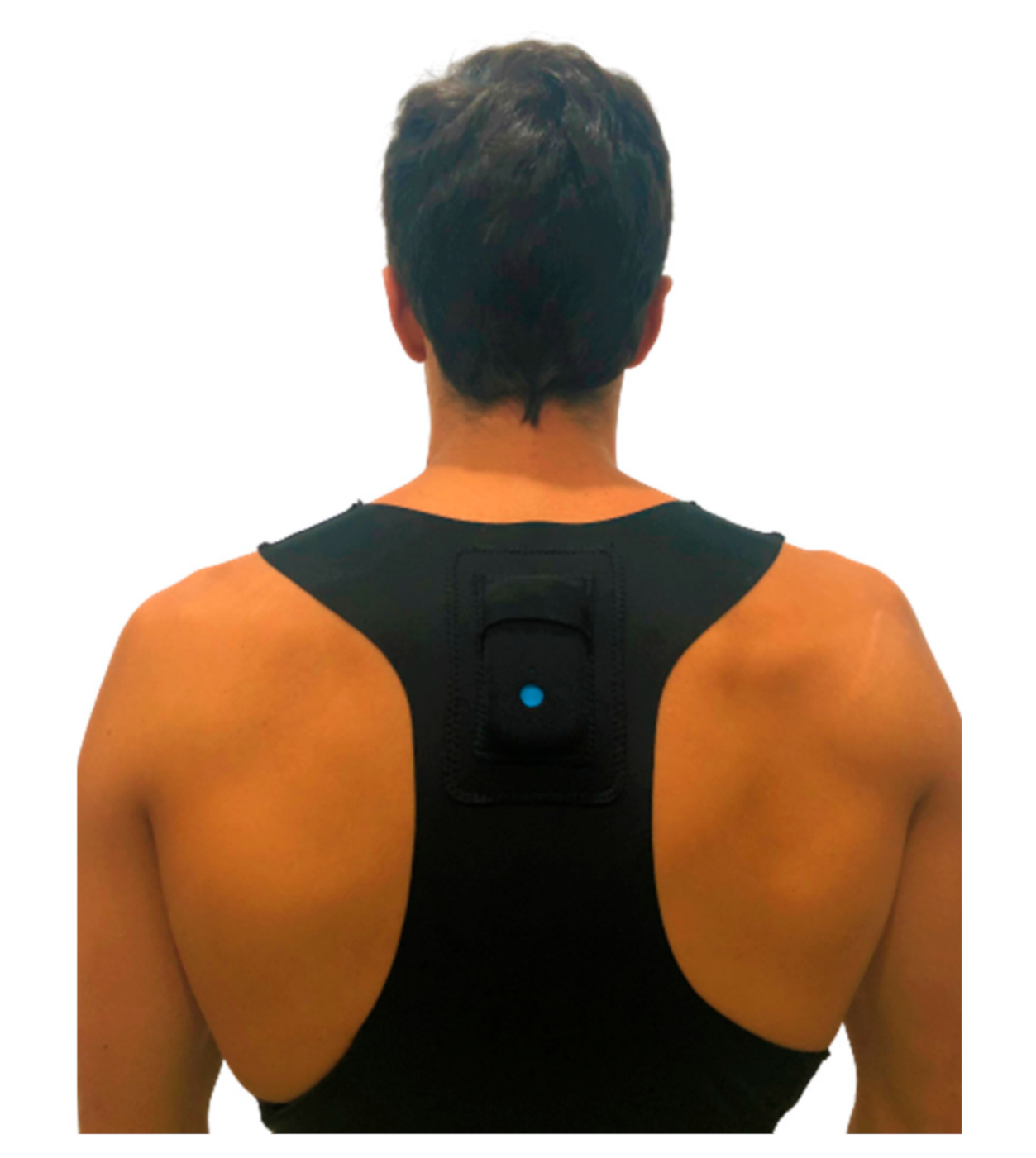
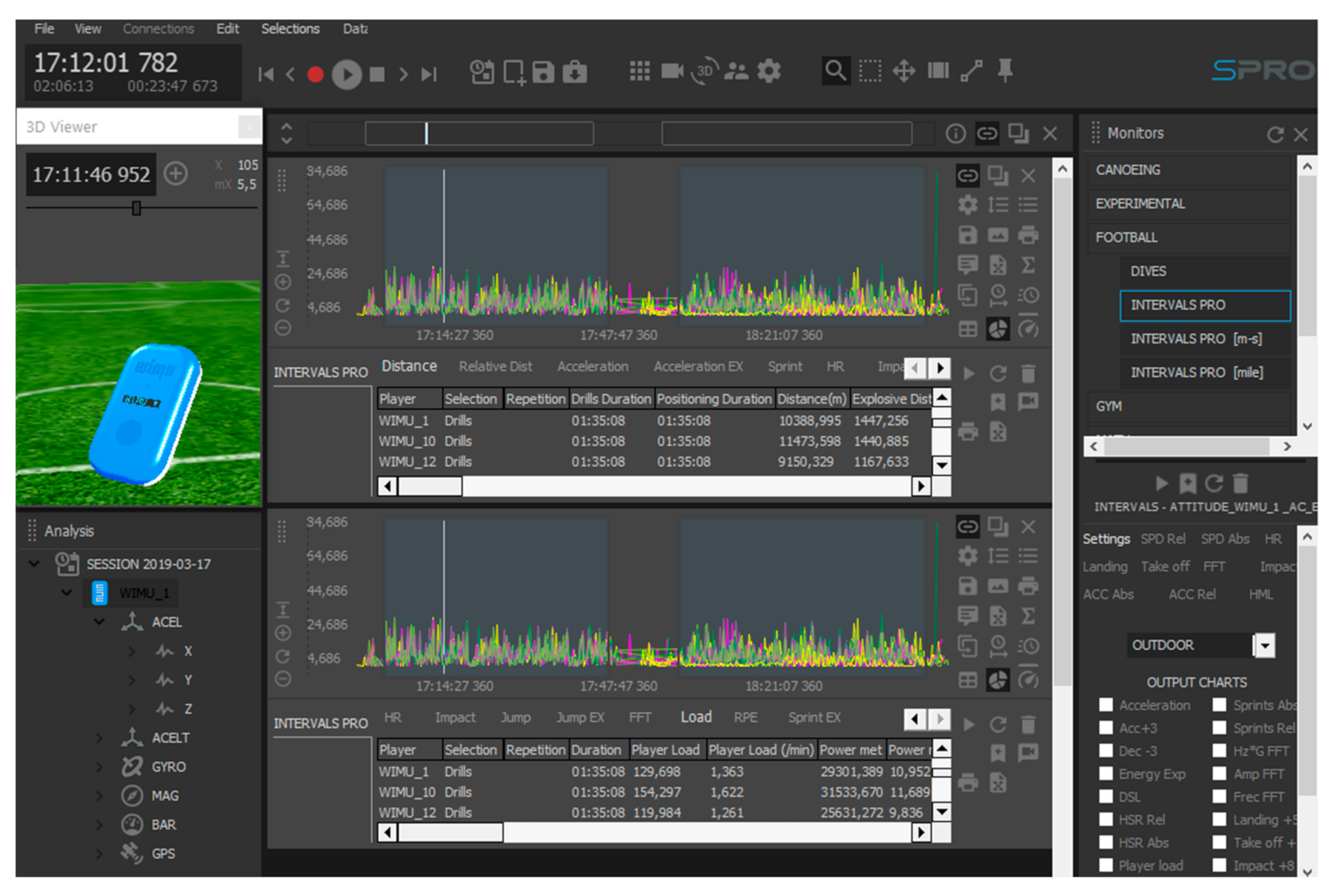
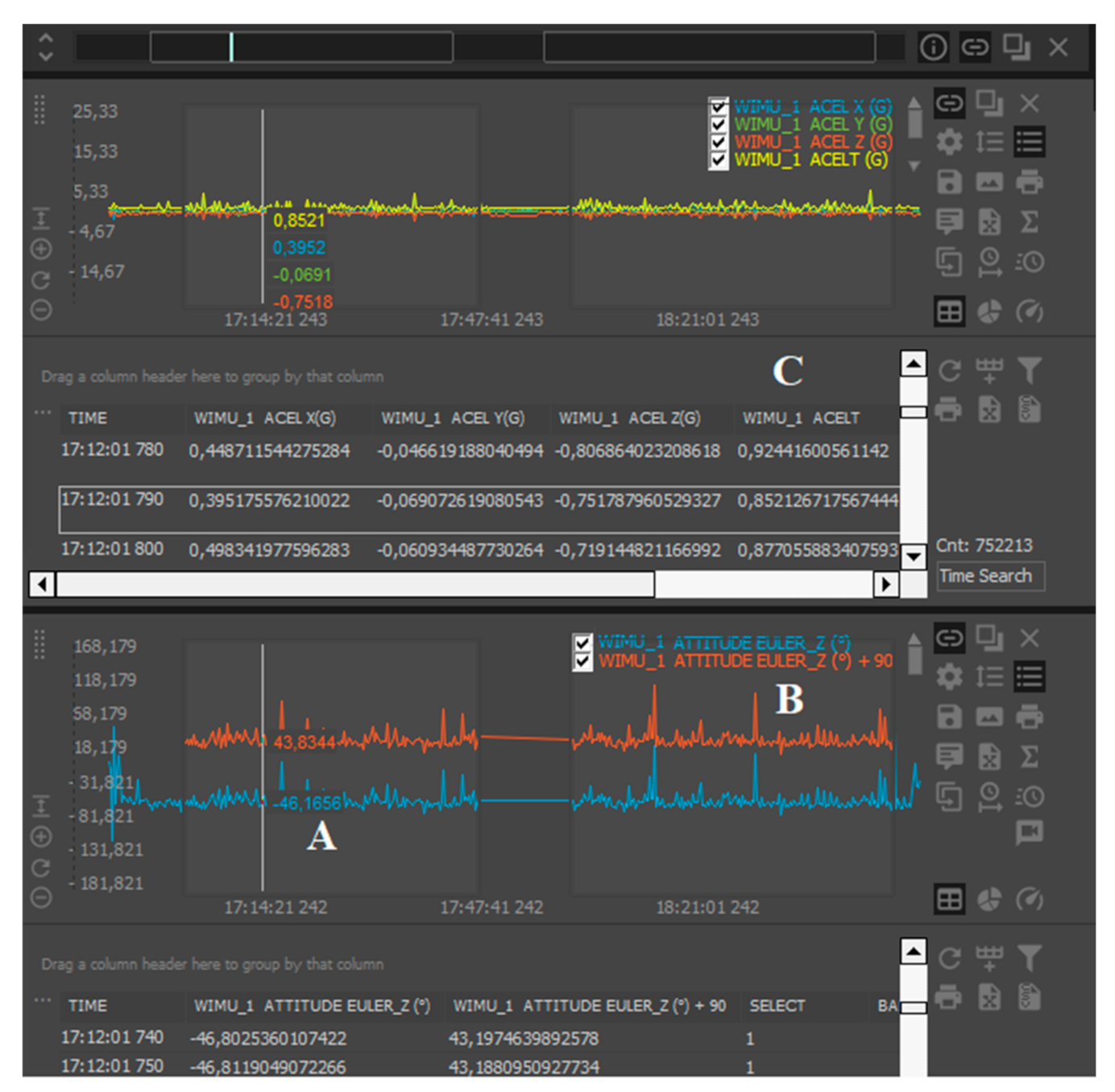
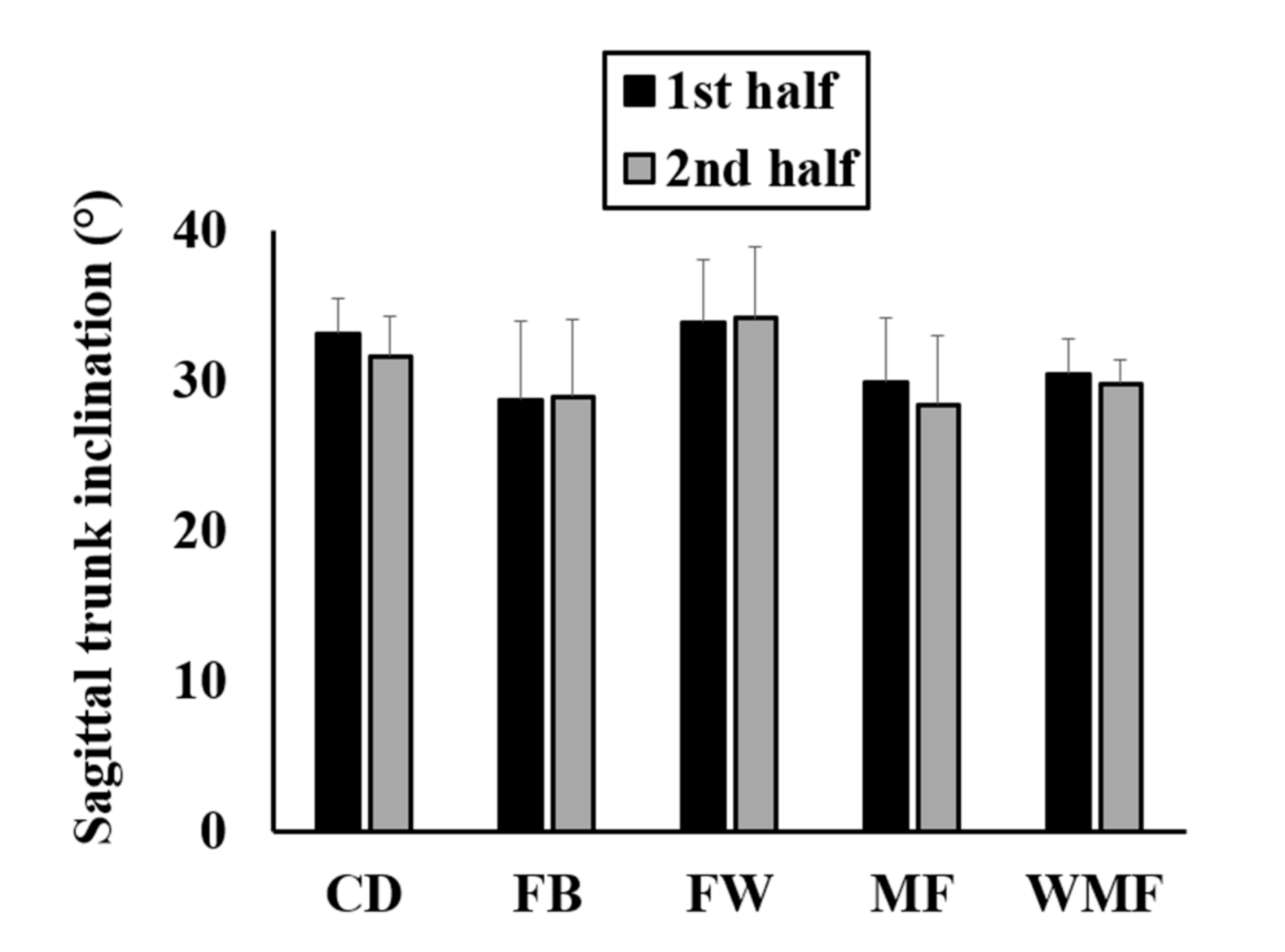
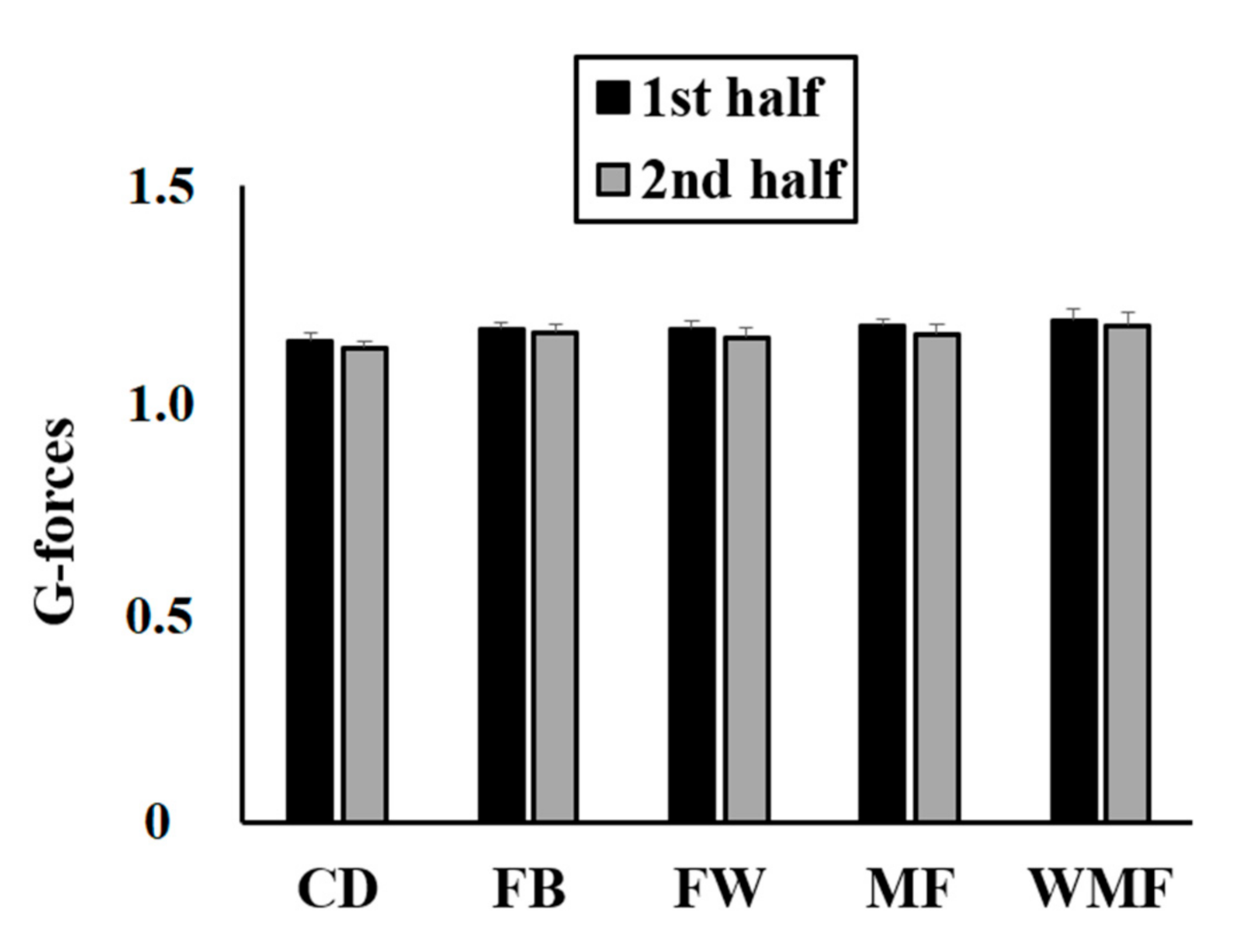
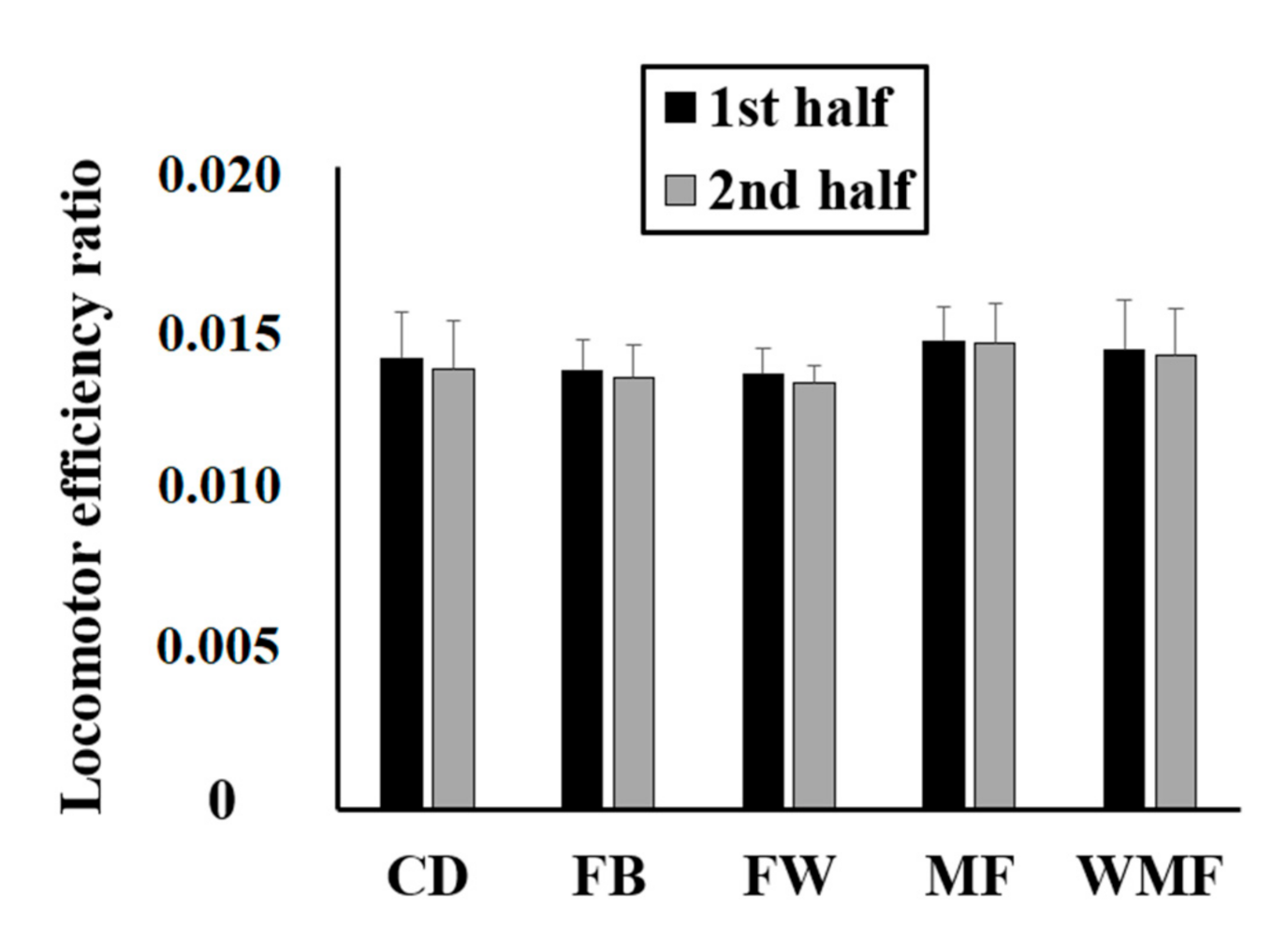
Publisher’s Note: MDPI stays neutral with regard to jurisdictional claims in published maps and institutional affiliations. |
© 2020 by the authors. Licensee MDPI, Basel, Switzerland. This article is an open access article distributed under the terms and conditions of the Creative Commons Attribution (CC BY) license (http://creativecommons.org/licenses/by/4.0/).
Share and Cite
Oliva-Lozano, J.M.; Maraver, E.F.; Fortes, V.; Muyor, J.M. Effect of Playing Position, Match Half, and Match Day on the Trunk Inclination, G-Forces, and Locomotor Efficiency Experienced by Elite Soccer Players in Match Play. Sensors 2020, 20, 5814. https://doi.org/10.3390/s20205814
Oliva-Lozano JM, Maraver EF, Fortes V, Muyor JM. Effect of Playing Position, Match Half, and Match Day on the Trunk Inclination, G-Forces, and Locomotor Efficiency Experienced by Elite Soccer Players in Match Play. Sensors. 2020; 20(20):5814. https://doi.org/10.3390/s20205814
Chicago/Turabian StyleOliva-Lozano, José M., Elisa F. Maraver, Víctor Fortes, and José M. Muyor. 2020. "Effect of Playing Position, Match Half, and Match Day on the Trunk Inclination, G-Forces, and Locomotor Efficiency Experienced by Elite Soccer Players in Match Play" Sensors 20, no. 20: 5814. https://doi.org/10.3390/s20205814
APA StyleOliva-Lozano, J. M., Maraver, E. F., Fortes, V., & Muyor, J. M. (2020). Effect of Playing Position, Match Half, and Match Day on the Trunk Inclination, G-Forces, and Locomotor Efficiency Experienced by Elite Soccer Players in Match Play. Sensors, 20(20), 5814. https://doi.org/10.3390/s20205814




